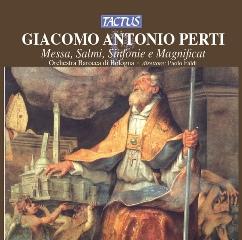Giacomo Antonio Perti - Messa a cinque, Magnificat, Salmi (Faldi) [2006]
Giacomo Antonio Perti - Messa a cinque, Magnificat, Salmi (Faldi) [2006]

Messa a cinque: 1 Sinfonia 1:34 2 Kyrie 3:46 3 Christe A Tre 2:25 4 Kyrie 1:52 5 Gloria 1:08 6 Et In Terra Pax 1:23 7 Laudamus Te 2:10 8 Domine Deus 2:00 9 Domine Filii Unigenite 1:41 10 Domine Deus Agnus Dei 1:57 11 Qui Tollis - Miserere Nobis 4:30 12 Quoniam Tu Solus 1:21 13 Cum Sancto Spiritu 2:23 14 Sinfonia Avanti La Messa 2:01 Salmi: 15 Laudate Pueri 1:51 16 Quis Sicut 2:25 17 Suscitans A Terra 1:22 18 Ut Collocet 1:21 19 Gloria Patri 2:32 20 Sicut Erat 1:43 21 Sinfonia Avanti La Messa 2:12 - 22 Dixit Dominus 9:11 23 Magnificat 7:34 Pamela Lucciarini, Silvia Vajente – soprano Gloria Banditelli - contralto Vincenzo Di Donato – tenor Gastone Sarti – bass Coro "Color Temporis" Orchestra Barocca di Bologna Paolo Faldi - conductor
Italy's Tactus label continues its laudable excavation of almost unknown music of the Italian Baroque with this disc of music by Giacomo Antonio Perti, a Bolognese composer who lived from 1661 to 1756 and was most active during the years on either side of 1700. He was the teacher of the young Mozart's Italian teacher, Padre Martini. The Anglophone listener will find little guidance to this unusual composer from the booklet. It is amusing when it tells of the "energy and animosity of the text," but less so in imponderable passages like this one, worth quoting in full: "The 'Tutti' which subscribes the score of the new Kyrie alluding at a rather vigorous continuo and a compact entry, almost like a concerto of a vocal or instrumental ensemble, is worthy of a concise setting regarding the dimensions of the piece and is also congealed, almost with the exactness of the imitative practice and always firm, noble and hieratic." Suffice it to say that this Bolognese music mixes the imposing choral style of seventeenth century Rome with fresh influences coming from points north. The music proceeds in short movements contrasting dense choral bursts with active solos. Several distinct works are mixed together on the album, perhaps with an eye toward a historically accurate breaking-up of the Messa a cinque that provides the framework. That mass is a short work, consisting only of a Kyrie and Gloria, the latter sectionally divided almost line by line. Interspersed are psalm settings and instrumental sinfonie, with a larger Dixit Dominus and Magnificat at the end. The layout of the whole program is musically convincing, and the music as a whole illuminates a distinct and still little understood stage in the march of Italian Baroque styles. The performances by the Coro "Color Temporis," the Orchestra Barocca di Bologna, and the five soloists are basic but never distracting from the task of communicating music that has lain undisturbed for hundreds of years. Recommended for large Baroque collections, personal and institutional. ---James Manheim, Rovi
Like most of Perti’s masses, this one consists of a Kyrie and Gloria set in movements for solo, ensemble, and choir. The psalm Laudate pueri is only slightly longer than Dixit Dominus , but it is similarly divided into movements, while the latter is given to the choir throughout, as is the Magnificat. The sinfonie , of which he wrote a number, are instrumental introductions to the Mass. Faldi is unknown to me, but he has assembled a fine ensemble that gives the composer his due. The solo and choral singers are well trained and responsive, and the orchestra is more than satisfactory. The extensive note is informative but requires some patience, for the translation is not fluent. This is a worthy tribute on the composer’s anniversary. --- J. F. Weber, arkivmusic.com
download (mp3 @320 kbs):
uploaded yandex 4shared mega mediafire solidfiles zalivalka cloudmailru oboom
